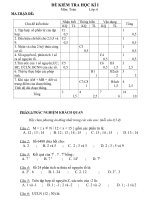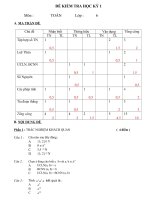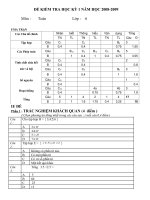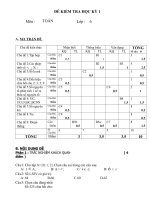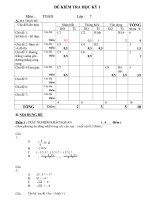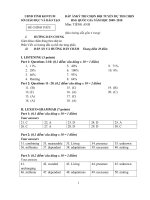click vào chữ read more để xem toàn bài và có thể download 1 bộ bài học internet marketing tiếng anh tuần 1 tuần 2 tuần 3 tuần 4 tuần 5 tuần 6 tuần 7 tuần 8 tuần 9 tuần 10 tuần 11 tuần 12 tuầ
Bạn đang xem bản rút gọn của tài liệu. Xem và tải ngay bản đầy đủ của tài liệu tại đây (97.49 KB, 17 trang )
<span class='text_page_counter'>(1)</span><div class='page_container' data-page=1>
Introducing Internet Marketing
</div>
<span class='text_page_counter'>(2)</span><div class='page_container' data-page=2>
Objectives
<i><b>• Subject Overview</b></i>
<i><b>• The Internet and the marketing concept</b></i>
<i><b>• Benefits of the Internet for businesses</b></i>
• The new marketing medium
</div>
<span class='text_page_counter'>(3)</span><div class='page_container' data-page=3>
Subject Overview
• General Aim and Rationale – the utility of
the Internet as a tool for business to increase
efficiency, competitiveness, and
effectiveness.
• Objectives
• Content
</div>
<span class='text_page_counter'>(4)</span><div class='page_container' data-page=4>
The Internet and the Marketing
Concept
•
<sub>Two distinct meaning for marketing</sub>
1. The range of specialist marketing functions
carried out by the firm (marketing research,
public relations..)
2. An approach or concept that can be used as
the guiding philosophy for all functions and
activities
</div>
<span class='text_page_counter'>(5)</span><div class='page_container' data-page=5>
The Internet and the Marketing
Concept
• The Internet can be applied by companies as an
integral part of the modern marketing concept
since:
– It can be used to support the full range of
organizational functions
– It is a powerful communication medium that integrates
the different parts of the organization
– It facilitates information management
</div>
<span class='text_page_counter'>(6)</span><div class='page_container' data-page=6>
Internet Marketing Defined
The use of the Internet and related digital
technologies to achieve marketing
objectives and support the modern
marketing concept.
</div>
<span class='text_page_counter'>(7)</span><div class='page_container' data-page=7>
Business Benefits of the Internet
<i>• Market penetration – sell more existing products </i>
into existing markets
<i>• Market development – Internet is used to sell into </i>
new markets
<i>• Product development – New products or services </i>
developed which can be delivered over the
Internet
</div>
<span class='text_page_counter'>(8)</span><div class='page_container' data-page=8>
Market and Product Strategic Grid
Market
Development
Diversification
Market
penetration
development
Product
<i>Existing</i> <i>New</i>
<b>Product</b>
<i>N</i>
<i>ew</i>
<i>E</i>
<i>xi</i>
<i>st</i>
<i>in</i>
<i>g</i>
<b>M</b>
<b>ar</b>
<b>k</b>
<b>et</b>
<i>Conservative </i>
</div>
<span class='text_page_counter'>(9)</span><div class='page_container' data-page=9>
Marketing Functions & The Internet
• Sales – achieve through increasing awareness of brands
and products, supporting buying decisions and enabling
online purchase
• Marketing communication – use of the web site for a range
of marketing communication
• Customer service – supplementing phone operators with
information available online
• Public relations – the Internet can be used as a new channel
for public relations (publish latest news on products)
</div>
<span class='text_page_counter'>(10)</span><div class='page_container' data-page=10>
The 6 Cs’ of the Internet
• Cost reduction – reducing the need for sales and marketing
enquiries to be handled by telephone and producing printed
marketing communication material
• Capability – The internet provides new opportunities for new
products and services and for exploiting new markets
• Competitive advantage – First mover advantage
• Communications improvement – improved communications with
customers, staff, suppliers
• Control – Better marketing research through tracking customer
behavior
</div>
<span class='text_page_counter'>(11)</span><div class='page_container' data-page=11>
The Internet – A New Marketing
Medium
• The Internet refers to the physical network that links
computers across the globe. It consists network servers and
wide-area communication links that are used to hold and
transport information.
• World Wide Web is a medium for publishing information on
the Internet.
• Intranet is a password protected network within a single
company which enables access to company information using
the familiar tools of the Internet such as web browsers.
</div>
<span class='text_page_counter'>(12)</span><div class='page_container' data-page=12>
<i>Level of management</i> <i>Internet</i> <i>Intranet and extranet</i>
Strategic Environmental scanning
Competitor analysis
Market analysis
Strategic decision making
Supply chain mgt
Internet data analysis
Management information
Marketing information
Database
Operations efficiency
Business planning
Monitoring and control
Simulation
Business intelligence (data
warehouses)
</div>
<span class='text_page_counter'>(13)</span><div class='page_container' data-page=13>
Internet Marketing Communications
• Characteristics inherent in digital medium:
– The customer initiates contact
– The customer is seeking information (pull)
– It is a high intensity medium – the marketer will have
100 per cent of the individual’s attention when he or
she is viewing a web site
– A company can gather and store the response of the
individual
</div>
<span class='text_page_counter'>(14)</span><div class='page_container' data-page=14>
Old and New Media
<i>Old media</i> <i>New media</i> <i>Comment</i>
One-to many
communication
model
One-to-one or
many-to-many communication
model
Hoffmann & Novak (1996)states that Internet is a
many-to-many medium, but for company to customer
one-to-one
Mass marketing Individualized
marketing or mass
customization
Personalization possible because of technology to
monitor preferences and tailor content (Deighton,
1996)
Monologue Dialogue Indicates the interactive nature of the WWW, with the
facility for feedback
Branding Communication Increased involvement of customer in defining brand
characteristics. Opportunities for adding value to
brand
Supply-side thinking Demand-side thinking Customer pull becomes more important
</div>
<span class='text_page_counter'>(15)</span><div class='page_container' data-page=15>
Internet marketing application in UK
<i>Use</i> <i>Percent</i>
PR/marketing information 70
Product contacts 40
Customer contacts 27
Facilitating customer feedback 20
Detailed product information 18
Distribution of paid-for reports 10
Online orders 8
</div>
<span class='text_page_counter'>(16)</span><div class='page_container' data-page=16>
Avoiding Marketing Myopia
• Traps that should be avoided when embarking on Internet
marketing:
– Wrongly defining which business they are in
– Focusing on:
• Products rather than customer
• Production
• Technology (only an enabler, not an aim)
• Selling (the culture of the Internet is based on customer seeking
information to make informed buying decisions)
• Customer needs (the need for market orientation is a critical aspect of
web site design and Internet marketing strategy)
</div>
<span class='text_page_counter'>(17)</span><div class='page_container' data-page=17>
Avoiding Marketing Myopia
– Unwillingness to innovate and ‘creatively destruct’
existing product/service lines
– Shortsightedness in terms of strategic thinking
– The lack of a strong and visionary CEO (Baker (1998)
found that this was important to companies’ using the
Internet effectively)
</div>
<!--links-->
